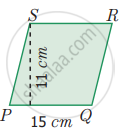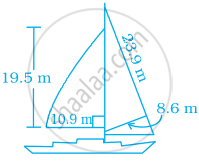Advertisements
Advertisements
प्रश्न
Find the missing value.
| Diagonal (d1) | Diagonal (d2) | Area |
| 19 cm | 16 cm |
उत्तर
Given diagonal d1 = 19 cm, d2 = 16 cm
Area of the rhombus = `1/2` (d1 × d2) sq.units
= `1/2` × 19 × 16
= 152 cm2
Tabulating the results we have
| Diagonal (d1) | Diagonal (d2) | Area |
| 19 cm | 16 cm | 152 sq.cm |
APPEARS IN
संबंधित प्रश्न
Lengths of the diagonals of a rhombus are 15 cm and 24 cm, find its area.
Lengths of the diagonals of a rhombus are 16.5 cm and 14.2 cm, find its area.
Each side of a rhombus is 18 cm. If the distance between two parallel sides is 12 cm, find its area.
The perimeter of a rhombus is 40 cm. If one diagonal is 16 cm; find:
- It's other diagonal
- area
Find the area of rhombus PQRS shown in the following figure.
A man has to build a rhombus shaped swimming pool. One of the diagonal is 13 m and the other is twice the first one. Then find the area of the swimming pool and also find the cost of cementing the floor at the rate of ₹ 15 per sq.cm
The figure ABCD is a quadrilateral in which AB = CD and BC = AD. Its area is ______.

Area of a rhombus = `1/2` product of ______.
The walls and ceiling of a room are to be plastered. The length, breadth and height of the room are 4.5 m, 3 m, and 350 cm respectively. Find the cost of plastering at the rate of Rs 8 per m2.
Most of the sailboats have two sails, the jib and the mainsail. Assume that the sails are triangles. Find the total area sail of the sailboats to the nearest tenth.

